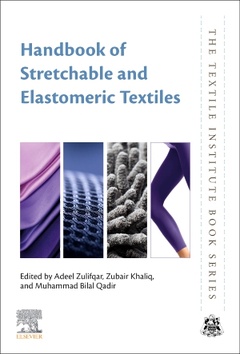Handbook of Stretchable and Elastomeric Textiles The Textile Institute Book Series
Coordonnateurs : Zulifqar Adeel, Khaliq Zubair, Qadir Muhammad Bilal

Handbook of Stretchable and Elastomeric Textiles is a comprehensive guide to everything you need to know about elastomeric textiles, including manufacturing techniques, physical properties, processing methods, and in-use care. All types of stretchable textiles are covered, including polymers, fibers, yarns, fabrics and composites. Starting with the fundamentals of the synthesis, properties and processing of elastomeric materials, this book goes on to help the reader choose the most appropriate parameters for manufacturing and processing, as well as the best elastomeric material according to specific end use applications. In general, elastomeric textiles are difficult to handle. During the manufacturing of elastomeric fabric, the handling of yarns is complicated. In addition, the processing stage is also challenging due to the heat sensitivity of the materials that affects how they are dyed, printed, washed and dried. The specific techniques required to produce a successful elastomeric textile have been developed over many years, hence this expertise is hard to come by.
2. Elastomeric yarns
3. Stretchable or elastomeric woven fabrics
4. Elastomeric/stretchable knitted fabrics
5. Elastomeric nonwoven fabrics
6. Elastomeric braided textiles
7. Stretchable and elastomeric textile reinforcements for composites
8. Wet processing of stretchable or elastomeric textiles
9. Stretchable or elastomeric textiles as wearables, smart and functional textiles
10. Applications of elastomeric textiles
Zubair Khaliq is an Assistant Professor in the Department of Polymer Engineering of the National Textile University, Pakistan. Before joining as a lecturer in 2009 he previously worked in industry. He completed his MS leading to Ph.D. in Organic & Nano Engineering from Hanyang University, South Korea in 2016. His research interests include the processing of polymeric materials’ nanostructure through physical and rheological studies.
Muhammad Bilal Qadir is an Assistant Professor at the Department of Yarn Manufacturing of the National Textile University, Pakistan. Before joining as a lecturer in 2010 he worked in the textile industry. He completed his Ph.D. in Organic & Nano Engineering from Hanyang University, South Korea in 2016. His research interests include elastomeric yarns and fabrics, functional and smart textiles, technical textiles, processing of nano structure polymeric materials through physical and rheological studies.
- Provides foundational knowledge on the polymeric structure of elastomeric fibers
- Explains how various materials can be used to prepare elastomeric fibers
- Addresses how elastomerics are being used in wearables and smart textile technologies
Date de parution : 05-2024
Ouvrage de 300 p.
15x22.8 cm



